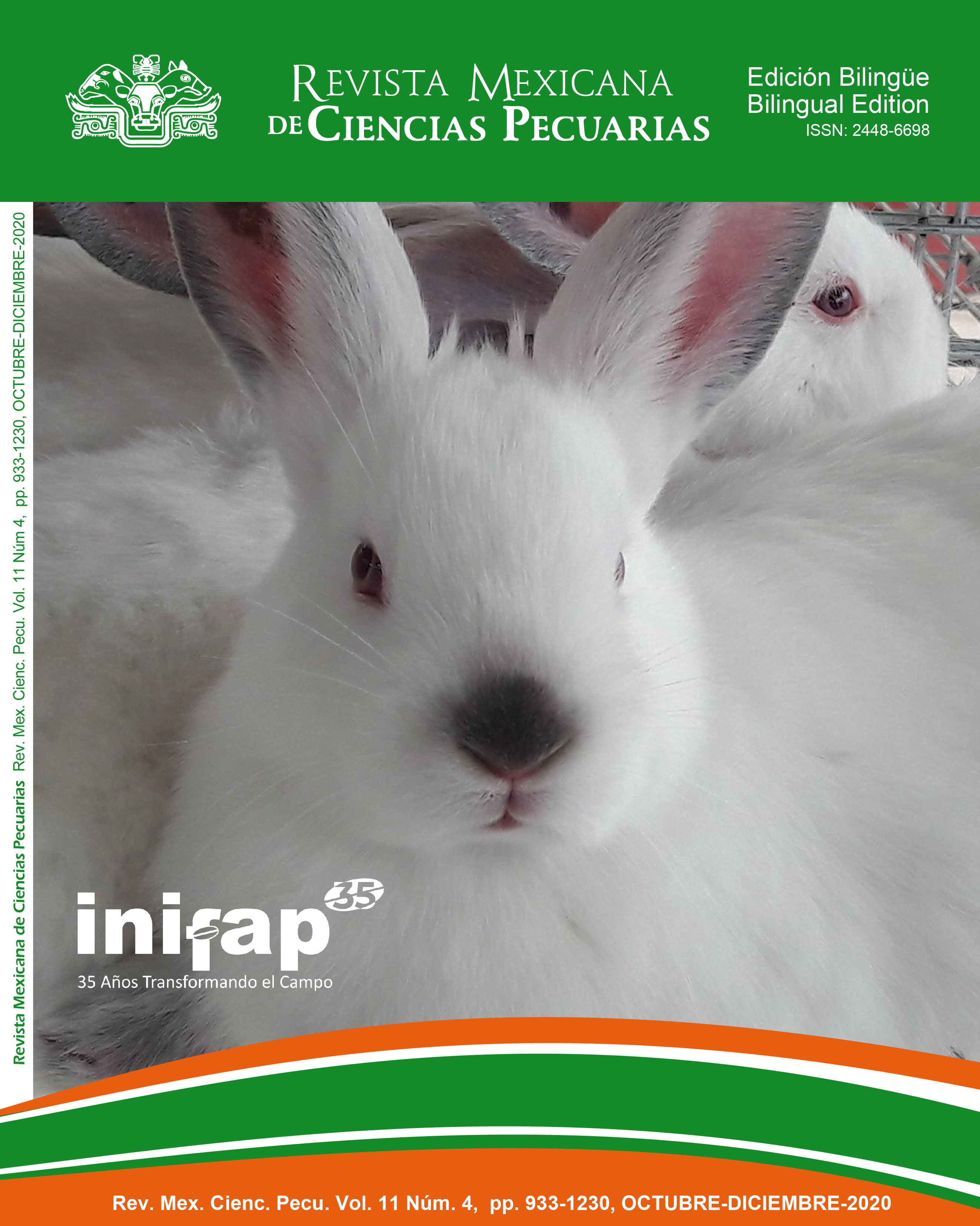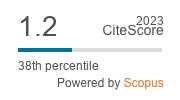Post vitrification pregnancy rate of in vivo produced embryos derived from equids. Review
DOI:
https://doi.org/10.22319/rmcp.v11i4.5437Palabras clave:
Mares, Jennies, Embryo, Cryopreservation, Vitrification, Pregnancy rateResumen
Vitrification is a cryo-preservation method often used in embryos obtained from mares or jennies. It consists in the dramatic reduction of temperature to levels close to -196 °C, that allows the cryopreserving solution containing the embryo to pass from liquid to vitreous state. Several improvements to vitrification protocols have made possible to cryo-preserve embryos with different sizes; since during the first decade after the year 2000, only small embryos were successfully vitrified. Embryos collected at the sixth day post ovulation (PO) are usually smaller or equal to 300 micrometers in diameter (≤ 300 µmØ) and can be routinely vitrified following simple protocols; they have a higher post vitrification pregnancy rate (PVPR) when compared to large embryos which have more than 300 micrometers in diameter (˃ 300 µmØ). The high PVPR of embryos ≤ 300 µmØ is due to an embryo capsule (EC) that is not fully developed yet and has a high permeability to cryo-preserving solutions. At present time, embryos collected either the seventh or eighth day PO are ˃ 300 µmØ and are characterized to have a low post vitrification survival; in order to increase their PVPR their EC might be punctured to make it permeable to cryopreserving solutions. Additionally, there are at least two factors that can be manipulated to increase the PVPR of embryos ˃ 300 µmØ; one is to reduce their size by aspiring their blastocoelic liquid (BL), and the other is to induce a high temperature transfer index (TTI) to rapidly reach -196 °C.
Descargas
Citas
FAO, 2018 Statistical Database Website, Food and Agriculture Organization. Rome Italy (Home page: http://www.fao.org/faostat/en/#data/QA).
Cox L. Dramatic decline in donkey populations blamed on consumer demand for 'ejiao'. Vet Rec 2017;(181):610.
Camillo F, Rota A, Biagini L, Tesi M, Fanelli D, Panzani D. The current situation and trend of donkey industry in Europe. J Equine Vet Sci 2018;(65):44-49.
Carneiro GF, Lucena JE, de Oliveira Barros L. The current situation and trend of the donkey industry in South America. J Equine Vet Sci 2018;(65):106-110.
Monti G, Bertino E, Muratore MC, Coscia A, Cresi F, Silvestro L, et al. Efficacy of donkey's milk in treating highly problematic cow's milk allergic children: an in vivo and in vitro study. Pediat Allergy Immunol 2007;(3):258-264.
Licitra R, Li J, Liang X, Altomonte I, Salari F, Yan J, et al. Profile and content of sialylated oligosaccharides in donkey milk at early lactation. LWT 2019;(115):108437.
D'Alessandro AG, Martemucci G, Loizzo P, Faccia M. Production of cheese from donkey milk as influenced by addition of transglutaminase. J Dairy Sci 2019;16615.
Getachew AM, Trawford AF, Feseha G, Reid SWJ. Gastrointestinal parasites of working donkeys in Ethiopia. Trop Anim Health Prod 2010;(42):27–33.
Vidament M, Vincent P, Martin FX, Magistrini M, Blesbois E. Differences in ability of jennies and mares to conceive with cooled and frozen semen containing glycerol or not. Anim Reprod Sci 2009;(112):22-35.
Hagstrom D. Donkeys are different: an overview of reproductive variations from horses. 2004. http://livestocktrail.illinois.edu/horsenet/paperDisplay.cfm?ContentID=7449 Accessed March 15, 2019.
Allen WR, Kydd J, Boyle MS, Antczak DF. Between‐species transfer of horse and donkey embryos: A valuable research tool. Equine Vet J 1985;(17):53-62.
Vendramini OM, Bruyas JF, Fieni F, Battut I & Tainturier D. Embryo transfer in Poitou donkeys, preliminary results. Theriogenology 1997;(47):409.
Pérez-Marín CC, Vizuete G, Galisteo JJ. Embryo recovery results in Hispano-Arabe horse and Spanish donkey breeds. Livestock Sci 2017;(206):76-81.
Oguri N, Tsutsumi Y. Non-surgical egg transfer in mares. Reproduction 1974;(41):313-320.
Eldridge-Panuska WD, di Brienza VC, Seidel Jr GE, Squires EL,
Carnevale EM. Establishment of pregnancies after serial dilution or direct transfer by vitrified equine embryos. Theriogenology 2005;(63):1308-1319.
Pérez‐Marín CC, Vizuete G, Vazquez‐Martinez R, Galisteo JJ. Comparison of different cryopreservation methods for horse and donkey embryos. Equine Vet J 2018;(50):398-404.
Bottrel M, Ortiz I, Pereira B, Díaz-Jiménez M, Hidalgo M, Consuegra R, et al. Cryopreservation of donkey embryos by the cryotop method: Effect of developmental stage, embryo quality, diameter and age of embryos. Theriogenology 2018;(125):242-248.
Freeman DA, Weber JF, Geary RT, Woods GL. Time of embryo transport through the mare oviduct. Theriogenology 1991;(36):823-830.
McKinnon AO, Squires EL. Equine embryo transfer. Vet Clin North Am Equine Prac 1988;(2):305-333.
Silva PC, Oliveira JP, Dutra GA, Paiva SO, Caram DF, Junqueira RG, et al. Taxa de recuperação e características morfológicas de embriões muares (Equus caballus x Equus asinus). Pesqui Vet Bras 2018;(7):1453-1457.
Panzani D, Rota A, Romano C, Pratelli G, Sabatini C, Camillo F. Birth of the first donkey foals after transfer of vitrified embryos. J Equine Vet Sci 2012;(32):419.
Bottrel M, Fortes T, Ortiz I, Hidalgo M, Dorado J. Establishment and maintenance of donkey-in-mule pregnancy after embryo transfer in a non-cycling mule treated with oestradiol benzoate and long-acting progesterone. Span J Agric Res 2017;(4):10.
Diaz F, Bondiolli K, Paccamonti D, Gentry GT. Cryopreservation of day 8 equine embryos after blastocyst micromanipulation and vitrification. Theriogenology 2016;(85):894-903.
Wilsher S, Rigali F, Couto G, Camargo S, Allen WR. Vitrification of equine expanded blastocysts following puncture with or without aspiration of the blastocoele fluid. Equine Vet J 2018;(0):1-6.
Camillo F, Panzani D, Scollo C, Rota A, Crisci A, Vannozzi I, et al. Embryo recovery rate and recipients' pregnancy rate after nonsurgical embryo transfer in donkeys. Theriogenology 2010;(73):959-965.
Betteridge KJ, Eaglesome MD, Mitchell D, Flood PF, Beriault R. Development of horse embryos up to twenty two days after ovulation: observations on fresh specimens. J Anat 1982;(135):191-209.
Iuliano MF, Squires EL, Cook VM. Effect of age of equine embryos and method of transfer on pregnancy rate. J Anim Sci 1985;(60):258-263.
Campos-Chillon LF, Suh TK, Barcelo-Fimbres M, Seidel GE Jr, Carnevale EM. Vitrification of early-stage bovine and equine embryos. Theriogenology 2009;(79):349-354.
Barfield JP, McCue PM, Squires EL, Seidel Jr GE. Effect of dehydration prior to cryopreservation of large equine embryos. Cryobiology 2009;(59):36-41.
Ottmann L, Reigner F, Allamellou JM, Magistrini M, Guignot F. Preimplantation genetic diagnosis in donkey embryos after biopsy. J Equine Vet Sci 2018;(66):195.
Ferris RA, McCue PM, Trundell DA, Morrissey JK, Barfield JP. Vitrification of large equine embryos following manual or micromanipulator-assisted blastocoele collapse. J Equine Vet Sci 2016;(41):64-65.
Stout TAE, Meadows S, Allen WR. Stage-specific formation of the equine blastocyst capsule is instrumental to hatching and to embryonic survival in vivo. Anim Reprod Sci 2005;(87):269-281.
Gillard Kingma SE, Thibault ME, Betteridge KJ, Schlaf M, Gartley CJ, Chenier TS. Permeability of the equine embryonic capsule to ethylene glycol and glycerol in vitro. Theriogenology 2011;(76):1540-1551.
Legrand E, Krawiecki JM, Tainturier D, Corniere P, Delajarraud H, Bruyas JF. Does the embryonic capsule impede the freezing of equine embryos? Proceedings of the 5th International Symposium on Equine Embryo Transfer, Havemeyer Foundation Monograph 2000;(3):62-65.
Scott BR, Carwell DB, Hill RA, Bondioli KR, Godke RA, Gentry GT. Evaluation of capsule permeability in the equine blastocyst. J Equine Vet Sci 2012;(32):795-798.
Legrand E, Bencharif D, Barrier-Battut I, Delajarraud H, Corniere P, Fieni F, et al. Comparison of pregnancy rates for days 7-8 equine embryos frozen in glycerol with or without previous enzymatic treatment of their capsule. Theriogenology 2002;(58):721-723.
Maclellan LJ, Carnevale EM, Coutinho da Silva MA, McCue PM, Seidel Jr GE, Squires EL. Cryopreservation of small and large equine embryos pre-treated with cytochalasin-B and/or trypsin. Theriogenology 2002;(58):717-720.
Guignot F, Blard T, Barrière P, Gasgogne T, Gaude Y, Yvon JM, et al. Easy, quick and cheap technique to cryopreserve Welsh B pony blastocyst. J Equine Vet Sci 2016;(41):53-60.
Choi YH, Velez IC, Riera FL, Roldán JE, Hartman DL, Bliss SB, et al. Successful cryopreservation of expanded equine blastocysts. Theriogenology 2011;( 76):143-152.
Sánchez R, Blanco M, Weiss J, Rosati I, Herrera C, Bollwein H, et al. Influence of embryonic size and manipulation on pregnancy rates of mares after transfer of cryopreserved equine embryos. J Equine Vet Sci 2017;(49):54-59.
Guignot F, Reigner F, Perreau C, Tartarin P, Babilliot JM, Bed'hom B, et al. Preimplantation genetic diagnosis in Welsh pony embryos after biopsy and cryopreservation. J Anim Sci 2015;(93):5222-5231.
Descargas
Publicado
Cómo citar
-
Resumen804
-
PDF 331
-
PDF183
-
Full text 82
Número
Sección
Licencia
Los autores/as que publiquen en la Revista Mexicana de Ciencias Pecuarias aceptan las siguientes condiciones:
De acuerdo con la legislación de derechos de autor, la Revista Mexicana de Ciencias Pecuarias reconoce y respeta el derecho moral de los autores/as, así como la titularidad del derecho patrimonial, el cual será cedido a la revista para su difusión en acceso abierto.

Esta obra está bajo una Licencia Creative Commons Atribución-NoComercial-CompartirIgual 4.0 Internacional.





